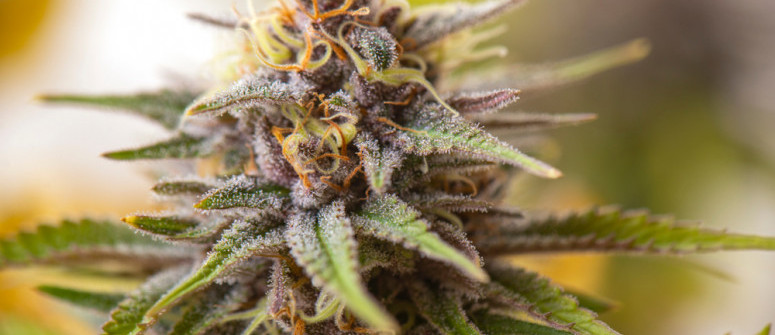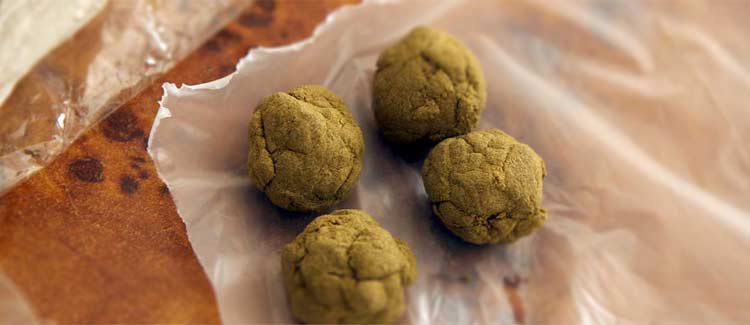Cannabis sugar leaves: how to use them

Are you guilty of throwing your sugar leaves on the compost pile? Just don't! This valuable resource contains THC and can be used to make cannabutter, hash, and other extracts if you know-how.
The size and quality of cannabis flowers is the true mark of every grow. But it’s not just buds that this industrious plant provides. Almost all aspects of the cannabis plant can be used in some way. The seeds provide a nourishing snack, the stems can be used to craft materials, and the roots can be decocted into a tea. The leaves also offer growers an additional source of cannabinoids. Sugar leaves feature particularly concentrated levels of these valuable molecules. While not nice smoke, there are other methods to harness their content.
Find out more about sugar leaves and how to use them.
PLANT ANATOMY: INTRODUCING SUGAR LEAVES
Cannabis plants produce two types of leaves. The large, broad leaves that emerge during the vegetative phase are called fan leaves. These structures are tasked with absorbing light and converting it into energy. The smaller leaves nestled within cannabis flowers are known as sugar leaves. This name stems from the frosty, sugar-like trichomes that cover their surfaces. They play a structural role within buds and help to keep them together.
CAN YOU SMOKE SUGAR LEAVES?
If you’ve ever purchased buds from a dispensary or coffeeshop, you may have noticed a lack of sugar leaves. Such establishments pride themselves on procuring thick, round nuggets of weed, void of stems and seeds. As well as looking nicer, this gives the customer the best price by weight. But the lack of sugar leaves goes further than aesthetics. Compared to buds, sugar leaves are harsh to smoke and leave a bitter taste in the mouth.
But just because sugar leaves aren’t ideal for smoking doesn’t mean they don’t have other uses.
COLLECT SUGAR LEAVES WHEN TRIMMING
.jpg)
Trimming is the act of manicuring cannabis flowers post-harvest. As well as resulting in higher quality buds, removing sugar leaves decreases the risk of mould infestation. They manage to trap air against bud surfaces, thereby increase moisture.
Cultivators opt to either dry trim or wet trim their harvest. Wet trimming refers to manicuring buds immediately after harvest when moisture levels are still high. This is usually a sticky operation, but provides a superior line of defence against mould in humid environments. Wet trimming also allows flowers to dry more quickly.
Dry trimming involves cleaning up buds after they have been dried. Entire branches are often hung from wire lines in warm rooms with low humidity. Although it takes longer to dry cannabis this way, this often results in more pleasant smells and tastes. Flowers develop more of a tight and compact look, too.
Dry trimming is the better path to tread if you plan on saving your sugar leaves. They’ll dry alongside flowers, and it’ll save you having to dry them out separately. When complete, trim them off over a collection tray using sharp scissors.
HOW TO USE SUGAR LEAVES
Sugar leaves contain reasonable levels of terpenes and cannabinoids—enough to make it a shame to discard them. Their potency isn’t on the same level as cannabis flowers, which is another reason smoking them isn’t ideal. The best option is to concentrate these valuable molecules to provide a more pronounced effect. This can be done by making tinctures, oils, hash, or other concentrates. Cannabis chefs also use sugar leaves when crafting edibles.
REMEMBER TO DECARB YOUR FOLIAGE
Before proceeding, it’s important to decarboxylate your leaves. This is a fancy word for making them psychoactive. In raw cannabis, THC exists as THCA, a non-psychoactive cannabinoid acid with its own array of benefits. If you’re looking to ingest this compound, you can simply sprinkle sugar leaves into a salad or other culinary preparation. If it’s a THC high you’re chasing, then you’ll need to decarboxylate them.
Decarboxylation occurs when THCA is subject to a temperature of 115° C for around 1 hour. This can easily be done at home in the oven. Heat causes a carboxyl group to eject from the molecule, leaving THC behind. This new molecular structure is capable of binding to receptors in your brain that initiate the cannabis high.
MAKE A POTENT TINCTURE
.jpg)
Tincturing is an old-school method of extraction that pulls the desired constituents from plant matter. It’s a straightforward procedure that involves bathing material in alcohol for extended periods. They can be taken almost anywhere inconspicuously and enter the bloodstream with haste when dropped under the tongue. You can also add drops into tea, juice, coffee, and other beverages.
To make a tincture, place your dried sugar leaves in a mason jar and cover them with alcohol. High-proof alcohol is more effective, but vodka will do if that’s all you have access to. Place your jar in a cool dark place and shake once a day. The extract will be ready after 2 weeks. Some tincture makers prefer to leave their extract to sit for much longer in hopes of increasing potency. However, the limited quantities of THC within sugar leaves make this unnecessary.
Strain your extract through a piece of cheesecloth or a fine sieve and into a pouring jar. Then carefully transfer the solution into dropper bottles using a small funnel. Be sure to store your tincture in a cool dry place when you’re not using it. This will help to prevent degradation.
The only downside to tinctures is dose accuracy. It’s simply a matter of experimentation. Start off with 1ml under the tongue and increase 1ml at a time accordingly until you find your sweet spot.
CRAFT CANNABUTTER FOR COOKING
Cannabutter is an easy extract to make and can be incorporated into an array of sweet and savoury dishes. The following recipe can be scaled up or down depending on the number of sugar leaves you have at your disposal.
INGREDIENTS
450g butter
1l water
30g of decarboxylated sugar leaves
DIRECTIONS
Place the butter, water, and sugar leaves into a pan and simmer over low heat for 4 hours, stirring every 30 minutes.
When cool enough to handle, strain the mixture through a colander lined with cheesecloth and into a large bowl. Use a spoon to press the spent leaves into the colander to force as much extract through as possible.
Place the bowl in the fridge for 2 hours. The butter will solidify on the surface, leaving a pool of water at the bottom of the bowl. Use a knife to slice the cannabutter and carefully remove it.
Store the extract in an airtight container in the fridge. Add it to any recipe that requires butter.
CREATE A HASH STASH

Hash is one of the oldest and most enjoyable ways to consume cannabis. This concentrated mass of trichomes provides a clean, pure, and euphoric experience. Because sugar leaves don’t produce as many trichomes as flowers, you’ll need quite a few to make a decent amount of hash.
One method of making hash involves dry sifting. That can be done by grinding up sugar leaves and allowing the trichomes to fall through a small mesh into the collection chamber below. If you only have a small number of leaves, then this is a feasible option. But this method will result in sore forearms, if you have a significant quantity.
Dry sifting can be performed on a large scale using mesh screen that increases in mesh size. During sifting, trichomes will fall through to a collection tray below, becoming separated from the plant matter.
Bubble hash is another option for making concentrates from sugar leaves. You’ll need a 1 gallon bucket and a bubble bag set. Bubble bags work in a similar way to the screen mentioned above and gradually decrease in mesh size.
Add a layer of ice in the bottom of the bucket and then add a layer of dried sugar leaves on top. Repeat this process until the bucket is full.
Next, fill the bucket to the top with water. Leave to cool for around 30 minutes. This will allow the trichomes to freeze, which makes them fall off the leaves. Stir the mixture with a wooden spoon constantly for 15 minutes to dislodge the trichomes.
Once the ice has melted, strain the liquid through the series of bubble bags. Varying qualities of hash will be left in each bag, with the highest potency product in the bottom bag. You can combine these together or keep them separate for different experiences. Use a hash press to forge your stash into a neat-looking coin that’s easy to store and transport.
.jpg)
.jpg)

.jpg)
